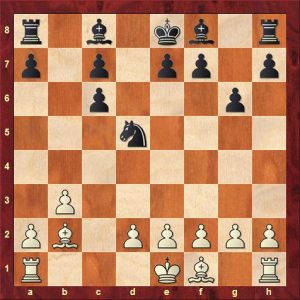The following article was published in Finnish Correspondence Chess Journal (issue 4/2015). I turned 70 that year. Text by Heikki Arppi.
Auno – 70 years!
 The World Championship final is the only qualification that is missing.
The World Championship final is the only qualification that is missing.
Auno Siikaluoma, 70, a correspondence chess player from Järvenpää is quite young as a correspondence chess player as his rise to the world elite has only taken about ten years. Auno first started to play correspondence chess using postcards inspired by Bobby Fisher’s championship in the 1970’s. It was only in the 2000’s when Auno really got interested in the game. This happened when he got hooked on the commercial servers and games that were now available also on ICCF server. After winning the 58th Finnish National Tournament Auno’s success has continued. Nowadays, the Grandmaster title is so difficult to achieve that the GM title which Auno Siikaluoma achieved on the 25th of August, 2012 and which he received the same autumn in the South Africa Conference is one of its kind in Finland in ten years’ time. Siikaluoma’s first norm for the GM title came in the Russian Correspondence Chess Association Celebration Tournament RCCA Gold 2008 when he came second with result 11,5/16. The final norm came in the Grandmasternorm -group 28 with result 8,5/12. Siikaluoma is the only Finn who has won the global Open Webchess tournament and won bronze in the Seniors’ World Cup. Auno’s biggest dream is to qualify to the World Championship Finals and have success in them. In addition to his successes in chess, in recent years, Auno has also given a great amount of his time to the Board of Finnish Correspondence Chess Federation. At the same time, he has been acting as the head organiser of ICCF’s Järvenpää Congress 2011. Furthermore, he is responsible for the web pages of the federation. As the director of the tournament, he is responsible for Finjub-50 celebration tournament.
A boy of the North
The family name ‘Siikaluoma’ refers to the wilderness of Northern Finland. A young man studied in Rovaniemi and later graduated from the University of Oulu. He got his degree in theoretical physics (Particle physics). Growing in number the family moved first to Espoo and then back to Oulu and finally to Tampere, where Auno worked as department manager in Tampere University Hospital. Now retired and re-married he still loves the fells of Lapland, orienteering and cycling. He also follows sports regularly, and why wouldn’t he, as his own grandson Martti Siikaluoma is one of the best milers in Finland.
The following game example is one of Siikaluoma’s most magnificent correspondence chess wins, which was played against Israeli Grandmaster Yoav Dothan.
GM Siikaluoma, Auno (2533) – GM Dothan,Yoav (2603) [A16],
ICCF Olympiad 18 final, board 3 ICCF, WebServer, 10.12.2012
(Siikaluoma, Auno)
My opponent, GM Dothan from Israel, was a very awesome and strong player. He was maybe the strongest player I ‘ve ever played against, because he had already twelve (12) grandmaster-norms. So he was at a like six times Grandmaster. In addition, he had played several times in the World Championship finals. So he’s a real chess talent in correspondence chess. He was a very difficult piece to win, for me playing with white pieces.
1. Nf3 Nf6
Reti opening, which get symmetrical answer,…drawish
2. c4
Now we are in english opening, I try to avoid symmetrical
2. …g6 3. Nc3 d5

English Anglo-Grunfeld-opening.
4.cxd5 Nxd5 5. Qa4+ Nc6
My opponent gives me an opening advantage. When I looked at the OTB-chess opening books, I noticed that white has won about 51% of the games. It’s challenging,… It is rarely played among the correspondence chess players and does not appear in the list of higher-level players. In fact, I had played a similar opening by the black in the 2nd Webchess Open Tournament – Final. The result was a draw.
6.Ne5 Qd6 7.Nxc6 Qxc6 8.Qxc6+ bxc6 9.b3

At this point, the game deviates from my previously played game. I make space for my bishop to develop. Among the correspondence chess games there was only one higher level game, SIM Romm, Mikhail Yakovlevich (2489) – SIM Matei, Cornel (2498). The tournament was the 69th European Individual Championship, Semifinal 3. The result was a draw.
9…Nxc3
This is the end the opening libraries and the help from other databases. When you look at the black’s c file, there are consecutive soldiers, which must be considered a weakness. The game could even be resolved by this like is later seen.
10.Bb2 Nd5

Black gives quality, but at the same time gets an almost irresistible counter-game.
11.Bxh8 f6 12.Rc1 Bd7 13.e4
The second option would have been 13. h4 …, but I chose the 13. e4 … to run the black horse out from the center and open the way for my bishop to evolve.
13…Nb6 14.Ba6 Rb8
Another perhaps even better option would have been Kf7, which would have enabled the move of e5 without my bishop getting rid of h8.
15.a4
Again, moving my opponent’s horse in my mind while my own soldiers are developing. Continuation 15.h4 Kf7 16.h5 gxh5 17.Rx5 Kg8 18.Bxf6 exf6 and you could see that black has even a slight advantage.
15…Kf7 16.a5 Na8 17.Bc4+ e6 18.e5
Another option would have been Rc3, but black would have got some benefit, so I chose the e5. 18.Rc3 Bd6 19.Bxf6 Kxf6.
18…Ba3 19.Bxf6

A sacrifice of quality that allows for white development to continue. The white soldier e5 and bishop f6 make a fun lock on the board, a lock that limits the movement of black significantly. At the same time, white space and mobility are considerably better than black.
19…Bxc1 20.h4
Now black would have had other options like c5 or Be8. Of these, maybe c5 would have been better.
20…h5
Continuation 20 … c5 would have opened the way for the black bishop Bd7 to join the game and the situation would have been almost even. 21.h5 g5 22.Rh3 h6 (22…Bb2 23.Rf3) 23.Rg3.
21.g4 Bb2

Continuation 21 … hxg4 would have led directly to the defeat 22.h5 gxh5 23.Rxh5 Kg6 24.Rg5+ Kh6 25.Rxg4 Be8 26.Rh4+ Bh5 27.Be2.
22.gxh5 gxh5 23.Be2 Kf8 24.Rg1
Take over the open line.
24…Rxb3 25.Bxh5 Rb5 26.f4 Rxa5
Black gets a free soldier, but gives a white awesome counter-game.
27.Rg7 Be8
Another option would have been 27 … Ra1 + 28.Kf2 Be8 29.Bxe8 Kxe8 30.Rg8 + Kf7 31.Rxa8 a5 32.h5 a4 33.Rc8 … and a clear draw.
28.Bxe8 Ra1+ 29.Ke2 Kxe8 30.Rg8+ Kf7 31.Rxa8 a5
The free soldier begins its march.
32.Rc8
Other options at 32. h5, and white would have some chance to win; 32.Rb8 and a clear draw.
32…Kg6
Black decides to stop the progression of the h-soldier, which in turn must be defeated.
33.Rg8+ Kf5 34.Bg5 Rc1 35.Kf3

So unbelievable as it is, Ra8 would have led to a draw regardless of any engine recommendation. 35.Ra8 Ba3 36.Rxa5 Bb4 37.Ra7 Rc2 38.Kd3 Rxd2 + 39.Kc4 c5 40.Rxc7 Rc2+ 41.Kb3.
35…Rf1+ 36.Kg2 Rd1 37.Rf8+ Kg4 38.f5

The soldier’s sacrifice and the black bishop disappears from the board.
38…exf5 39.e6 Ba3 40.Rg8 f4 41.Be7+ Kf5 42.Bxa3 Rxd2+
At the same time, there was another soldier’s disappearance and the game continues to be fairly even and exciting.
43.Kh3 Rd3+ 44.Kh2 Kxe6

Continuation 44 … Rxa3 black straight defeat with 45.e7 c5 46.e8Q.
45.Bc1
Black has three free soldiers against a white bishop and one free soldier … phew …
45…a4
Continuation 45 … Rd4 and white wins 46.Rf8 a4 47.Rxf4 c5 48.Kg3 Rd3+ 49.Kg4 Rd1 50.Ba3 Rg1+ 51.Kh5 Ra1 52.Rxa4 c4 53.Ra7.
46.Bxf4

One free soldier less. To control other black free soldiers white must move his bishop to diagonal a1-h8. At the same time, the white h-soldier must give pressure to black to bind his tower or king to prevent it from advancing.
46…a3 47.Bxc7
Continuation 47.Ra8 and it’s draw 47 … Kf5 48.Bc1 Rc3 49.Bxa3 c5 50.Ra4 Kg6 51.Kg1 Kf5 52.Kf2 Kg6 53.Rg4 + Kh6 54.Rg3 Rc2 + 55.Ke3 Rc4 56.Kd3 Rxh4 57.Bxc5 and the result can be checked even though from Nalimov’s tables.
47…c5 48.Rg6+
Now we are at the final turning point. Black selects the move
48…Kd7

It would have been better to move Kd5 and a draw continuation. 48 … Kd5 49.Rd6 + Kc4 50.Rxd3 Kxd3 simple but true. The king should have gone where the battle is. At this stage of the game, the king is already one of the fighting pieces and is not just a button that needs to be protected. I do not understand the move that black had chosen, except that it comes from the abyss of a computer engine, Rybka or someone else. The black move gives the white bishop a diagonal a1-h8 and is at this stage a very decisive factor in the outcome of the game.
49.Be5 c4 50.Ra6 Bb3 51.Rd6+ Kc7
(51…Ke7 52.Rc6 Re3).
52.Rd1+
52. h5 … and here was a small temptation and at the same time a trap that would have led to draw 52 … Re3 53. Bf4 Rf3 54. Rf6+ Kd7 55. h6 a2 56. Be5 c3 57. Rd6+ Ke7 58. Ra6 c2 59. Bb2 Rb3 60. Bc1 Rb1 61. Bg5+ Kf7 62. h7 Rb8 63. Rxa2 Rh8 64. Rxc2 Rxh7+ …
52…Kc6 53.Rc1 a2 54.Rc2 Ra3 55.Ba1 Kd5 56.Kg2 Ke6 57.Rxc4

At this point, we then moved to Lomonosov’s end game tables, which I had access to. Of course the sequel to the game would have been useless, but I did not mention it to my opponent. I decided to change the length of time and the day. On the other hand, I do not know if my opponent had the corresponding information source at his disposal. Well the game continued for a while …
57…Kf5 58.Kh2 Kg6 59.Rc3 Ra5 60.Kg3 Kh6 61.Rf3 Kh5 62.Rd3 Ra4 63.Rd5+ Kh6 64.Rf5 Ra8 65.Kg4 Ra4+ 66.Rf4 Ra8 67.Rf6+ Kh7 68.Rf5 Kh6 69.Rh5+ Kg6 70.Rd5 Kh6 71.Rd6+ Kh7 72.Rd7+ Kh6 73.Bg7+ Kh7 74.Bc3+ Kg8 75.Ba1 Ra4+ 76.Rd4 Ra6 77.h5 Kf7 78.Rb4 Ke7 79.Rf4 Ke8 80.Kg5 Ra5+ 81.Rf5 Ra3 82.h6 Rg3+ 83.Kf6 Rh3 84.Kg6 Rg3+ 85.Rg5
1–0
Some highlights…
Black sacrifices quality at the beginning of the game and at the same time gets strong counter-play. Was this a mistake or not is left to be considered by the investigator of this game?
White sacrifices quality back and at the same time achieves a lock on the board to limit the black’s space of movement.
White sacrifices two soldiers and receives a black bishop in return, so not really a sacrifice.
Black makes its decisive mistake in move 48. … Kd7. It would have been right 48. … Kd5.
In a typical correspondence chess style … neither players of the game did the castling.
Annotations …
Auno Siikaluoma, GM (ICCF)
